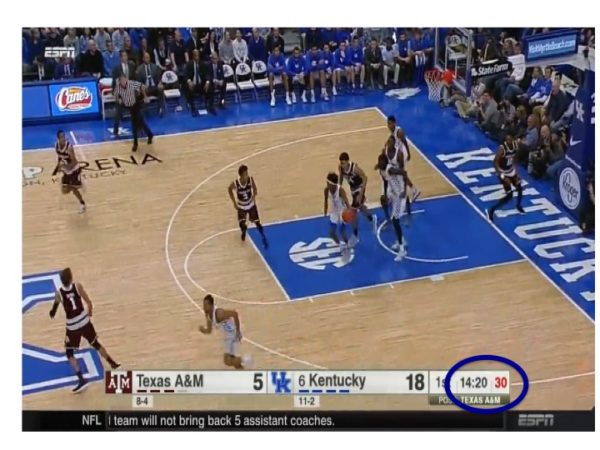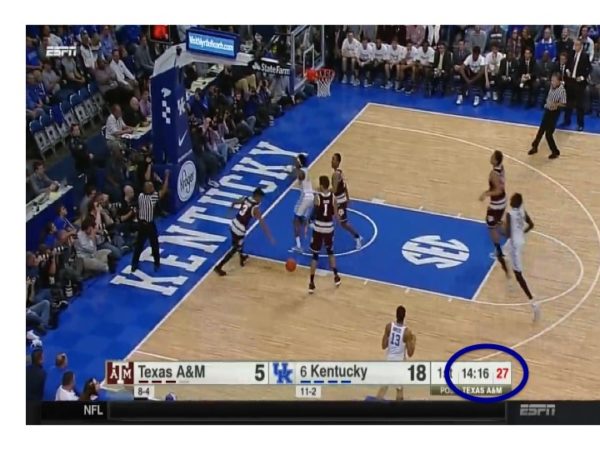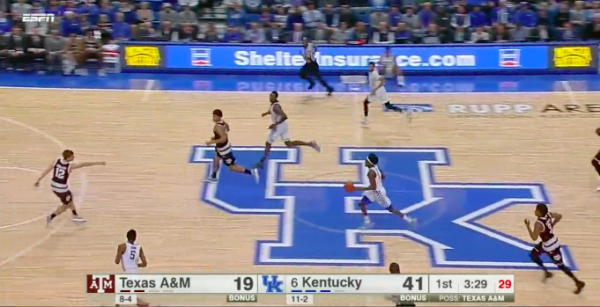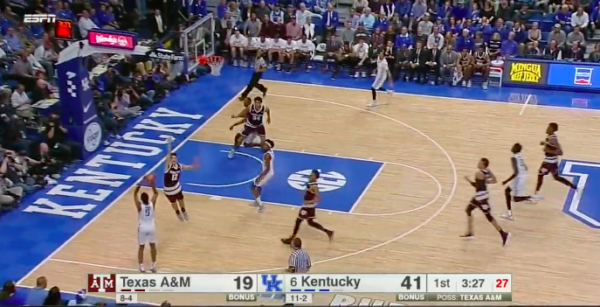Freeze Frame: Kentucky’s Early Offense
Posted by Brian Joyce on January 6th, 2017During this week’s television broadcast of the Kentucky-Texas A&M game, viewers could hear Wildcats’ head coach John Calipari yell “Go! Go! Go!” at the top of his lungs seemingly every time the Wildcats touched the ball. Calipari is simply exhorting his team to play to its strength, which, as you may have noticed, seems to be working. The Wildcats are currently the ninth-fastest team in college basketball (average possession length of 14.0 seconds), but what Calipari knows is that his team runs much better offense the faster it goes.

Kentucky’s early offense in SEC play.
As the above table shows, when Kentucky shoots the ball in the first 10 seconds of the shot clock, its offensive efficiency comes in at a blistering 147.8 points per 100 possessions (over the 153 total possessions I have charted during conference play). However, if the Wildcats’ offense runs past the 10-second mark on the shot clock — effectively dropping back into the half-court offense — it drops to an an offensive efficiency rating of 107.7; effective field goal percentage drops over 20 percentage points; turnover percentage increases; offensive rebounding percentage decreases; and, free throw trips drop. In other words, outcomes are a lot better for the Wildcats when they get a shot up within the first 10 seconds. In this edition of Freeze Frame, we analyze Kentucky’s offensive efficiency by possession length.
It probably goes without saying that freshman point guard De’Aaron Fox is a big reason why Kentucky plays so much faster this season than in any other year of the Calipari era. Fox is lightning-quick with the ball, and Kentucky doesn’t run transition just on live ball turnovers alone. Here, Fox grabs a defensive rebound with 14:20 left on the clock. and tears downcourt.

Fox grabs the rebound and takes off.
He quickly ends up with a two-on-three Kentucky break with Isaiah Briscoe spotting up on the perimeter. Fox opts to take the ball into the lane instead, drawing the foul, and completing the possession in a total of four seconds. Remember that this was possession was off of a defensive rebound rather than a turnover.

Fox takes on three Aggies and finishes the play at the free throw line in four seconds.
His speed with the ball completely changes the way Kentucky plays, as is evident with the splits I charted with Fox on and off the court. Briscoe ran point for the Wildcats in almost all of the 54 possessions without Fox on the floor, and, as the below tables show, the difference in Kentucky’s possession length with and without its freshman point guard on the floor is astounding.

Kentucky plays significantly faster with Fox on the court.
With Fox on the floor, Kentucky used nearly 62 percent of its possessions within the first 10 seconds of the shot clock. That number drops to under 40 percent when he is on the bench.

The Cats slow way down with Fox on the bench.
Kentucky’s other star freshman guard has a big impact on the offense too, but his game may be better in a slower pace. In this week’s power rankings, Sports Illustrated’s Luke Winn pointed out an interesting tidbit about Malik Monk’s outside shooting, which is that Monk hits just 26.7 percent of his threes in transition compared with almost 50 percent in the half-court. Given his recent performances, Kentucky may prefer to see an ill-advised three-pointer from Monk than any kind of shot from anyone else, but there are a couple of things to note about his outside shooting. His hot three-point shooting in the half-court may be skewing some of this shot clock efficiency data because he frequently bails the Wildcats out at the end of a possession. We also can see from the frames below how, when Monk pulls up for transition threes, he often takes away a shot at the rim from someone else. Here, we see Fox lead a four-on-two Kentucky break after a live-ball turnover.

This 4-on-2 break should end in points for Kentucky.
Fox finds Monk spotting up on the wing. Texas A&M’s Chris Collins gets a hand up on him to contest the long-range jumper. In this spot, Calipari likely would have preferred that Monk drive the lane, either getting fouled or drawing enough defensive attention for a lob to Bam Adebayo cutting to the basket.

Monk needs to drive the lane in transition.
Kentucky’s early offense and the impact that freshman guards Fox and Monk have on how the Wildcats play is a development that warrants further attention throughout the season. We will continue to chart the Wildcats’ offensive efficiency by length of possession as conference play wears on. For now, the strategy is crystal clear. Anyone with the volume turned up on their TVs heard Calipari — he expects the Wildcats to play fast and “Go!”












































